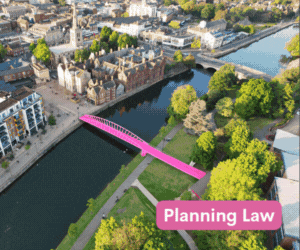Surface water and flood risk
A Planning Policy Guidance (PPG) change could easily mop up this surface water flood risk sequential test mess, writes Simon Ricketts.
- Details
It’s finally raining properly this morning. What else could I write about…?
The government’s general advice is that planning permission shouldn’t be granted for development in flood risk areas without an assessment first being carried out as to whether the development could be accommodated in a lower risk area. Fair enough, but a change to the government’s planning practice guidance in 2022 for the first time expressly extended this advice to “areas at risk of surface water flooding“, rather than just areas at risk of flooding from rivers or the sea.
Paul Smith wrote a brilliant explainer on this issue from a developer’s perspective in his 4 April 2025 blog post How puddles could stop the government building the homes we need.
The December 2024 version of the NPPF didn’t resolve the problem but at least alleviated it with the emboldened passage:
“170. Inappropriate development in areas at risk of flooding should be avoided by directing development away from areas at highest risk (whether existing or future). Where development is necessary in such areas, the development should be made safe for its lifetime without increasing flood risk elsewhere.”
“172. All plans should apply a sequential, risk-based approach to the location of development – taking into account all sources of flood risk and the current and future impacts of climate change – so as to avoid, where possible, flood risk to people and property. […]
“173. A sequential risk-based approach should also be taken to individual applications in areas known to be at risk now or in future from any form of flooding, by following the steps set out below.
174. Within this context the aim of the sequential test is to steer new development to areas with the lowest risk of flooding from any source. Development should not be allocated or permitted if there are reasonably available sites appropriate for the proposed development in areas with a lower risk of flooding. The strategic flood risk assessment will provide the basis for applying this test.
175. The sequential test should be used in areas known to be at risk now or in the future from any form of flooding, except in situations where a site-specific flood risk assessment demonstrates that no built development within the site boundary, including access or escape routes, land raising or other potentially vulnerable elements, would be located on an area that would be at risk of flooding from any source, now and in the future (having regard to potential changes in flood risk).”
The problem is that we are still currently left with the specific reference in the PPG to the need for a sequential test in relation to areas at risk of surface water flooding (the passage I have emboldened) (and Mead Realisations v Secretary of State (Court of Appeal, 30 January 2025) of course tells us that there is no “legal principle that prevents national policy in the NPPF being amended, or altered, by guidance in the PPG.”):
“What is the aim of the sequential approach?
The approach is designed to ensure that areas at little or no risk of flooding from any source are developed in preference to areas at higher risk. This means avoiding, so far as possible, development in current and future medium and high flood risk areas considering all sources of flooding including areas at risk of surface water flooding. Avoiding flood risk through the sequential test is the most effective way of addressing flood risk because it places the least reliance on measures like flood defences, flood warnings and property level resilience features. Even where a flood risk assessment shows the development can be made safe throughout its lifetime without increasing risk elsewhere, the sequential test still needs to be satisfied. Application of the sequential approach in the plan-making and decision-making process will help to ensure that development is steered to the lowest risk areas, where it is compatible with sustainable development objectives to do so, and developers do not waste resources promoting proposals which would fail to satisfy the test. Other forms of flooding need to be treated consistently with river and tidal flooding in mapping probability and assessing vulnerability, so that the sequential approach can be applied across all areas of flood risk.
Paragraph: 023 Reference ID: 7-023-20220825
Revision date: 25 08 2022”
The Government had indicated in its 12 December 2024 response to the revised NPPF consultation process that it would “shortly be updating planning practice guidance to clarify the definition of reasonably available sites that should be considered as part of the sequential test”. We still wait for that updated guidance and in particular to see if it will address this particular difficulty over surface water flood risk. Paul’s blog post explains well the nonsense of, and work and cost involved in, carrying out a sequential test looking for sites at lower risk of surface water flooding.
Pending any amended guidance, there have at least recently been some pragmatic appeal decisions by inspectors, most recently:
Ham Road, Faversham, Kent (27 June 2025) This is summarised by Zack Simons KC in his 4 July 2025 blog post Floods, puddles and “strong” refusals (which also references two other recent decisions: Yatton (albeit that this is subject to legal challenge) and HMP Garth and Wymott, Lancashire. The Faversham inspector was faced with an appeal where no sequential test had been carried out despite the site being at risk of both flooding from the sea and by way of surface water. “The proposal includes changing the land levels, including raising them in some areas, with the result that all areas of proposed built development would be some 300mm above the design flood level, ie would not be at risk of flooding. This could be secured by conditions(s).”
“The extent of pluvial flooding risk is relatively limited. It is from ponding on the site in existing depressions and similar factors. The depth of the flooding would be relatively shallow. There is no risk related to interrupting an off-site surface water flow path, or effects on other off-site properties. It is a fairly typical existing situation on an agricultural field. As part of the design detail for the proposal at reserved matters stages, the precise land levels, drainage solutions, and landscaping would all need to be considered. Given the limited nature of the existing and future surface water flood risk, designing out the flood risk could be comfortably accommodated as part of this natural detailed design process.
Overall, therefore, there is no real world harm from either the failure to undertake a sequential test for tidal flooding or the failure to properly undertake a sequential approach. This is because it has been satisfactorily demonstrated that mitigation measures can make the proposed development safe for its lifetime from tidal flooding. There are also reasons other than flooding that result, although likely only in part, in the land levels changing mitigation measures. There would also be no real world surface water flood risk to the finished and occupied development proposal.”
Nor was the failure to carry out the sequential test a “strong reason for refusal” such as to disapply the tilted balance in favour of granting permission (which applied diue to the local authority’s poor housing land supply position).
Appeal allowed.
Sherwood Cross, Feniton (11 July 2025). Here, the site is “conducive to overland water flow in high rainfall events”. Water attenuation is proposed to the north of the site to protect the development site but also to provide overall betterment, the details of the proposed attenuation scheme to be the subject of a Grampian condition.
“The Sequential Test undertaken by the Appellant has not considered potential housing sites in the wider local authority area, as identified by the Council. That is on the basis of the Appellant’s claimed position that the proposal would uniquely include flood alleviation measures that would significantly lessen the flood risk off- site within that part of Feniton to the south of the site along Colestocks Road and further to the south, and that there are no other sites that could provide such benefits to Feniton. However, whilst the flood mitigation measures are an element of the proposal, as previously referred to, the northern attenuation areas have a dual function including to protect the proposed development from any flood risk.
The proposal is therefore fundamentally a housing scheme with attenuation measures necessary, in the absence of any other proposed mitigation, to protect it from flood risk, which would also take the opportunity to provide betterment to off- site flood risk. There is no substantive evidence to indicate that the various other potential sites for housing put forward by the Council would be unsuitable or not have a lower risk of flooding. As such, I have no substantive basis to find that there are no reasonably available sites appropriate for the proposed development in areas with a lower risk of flooding. The proposed development therefore fails the sequential test, in conflict with the Framework in this respect.”
However, the inspector goes on to conclude:
“I have also found that, in respect of flood risk, the proposal fails the sequential test and does not fully accord with policy EN22 of the Local Plan and F1 of the NP, having regard also to the absence of an agreed surface water outfall. However, I have also found that there would be likely betterment relating to off-site flood risk resulting from the proposals, in the context of the proposals making the development safe without increasing flood risk elsewhere. That would be subject to compliance with a Grampian condition to secure acceptable surface waterdrainage, which I have found would be appropriate in the circumstances of this case. Those factors therefore lessen the weight afforded to the above failures relating to the sequential test and development plan policy.”
Appeal allowed.
This pragmatism is all well and good but to assume pragmatism on the part of all decision-makers in the planning system is a mug’s game. Which is why we just need some clear guidance: of course if there is no certainty that any unacceptable risks arising cannot robustly be mitigated, surface water flood risk can and should be the basis for refusal of a planning application, but the sequential test should only be required in the case of sites at risk from flooding from rivers or the sea.
Simon Ricketts is a partner at Town Legal. This article first appeared on his Simonicity planning law blog.
Contracts & Procurement Lawyer
Lawyer - Property
Trust Solicitor (Employment & Contract Law)
Senior Lawyer - Contracts & Commercial
Locums
Poll









































